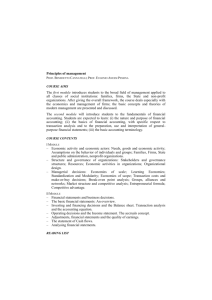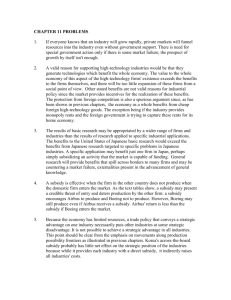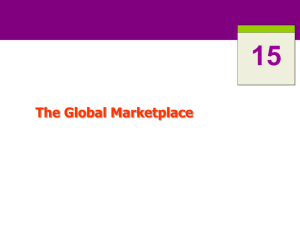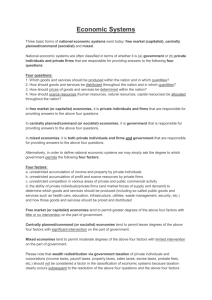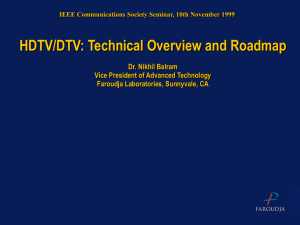State-Centered Approach to Trade Politics
advertisement
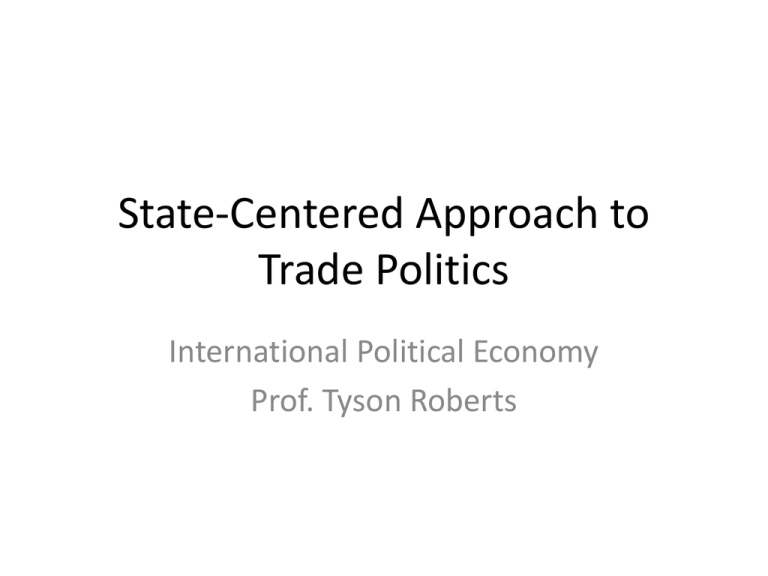
State-Centered Approach to Trade Politics International Political Economy Prof. Tyson Roberts Lecture goals • • • • State vs. society based model Infant industry argument Strategic trade argument Strong vs. weak states Assumptions of society- vs. statecentered approach Society-centered Government intervention in trade… Trade policy reflects… State-centered always reduces state sometimes welfare promotes state welfare balance of power goals of national among societal decision makers interests Determinants of trade patterns • Standard economic theory can explain why the US sells cars to Colombia and Colombia sells coffee to US … – Factor endowments => comparative advantage • But cannot explain why Japan, US, and Germany sells cars to one another Infant industry protection • If barriers to entry are low, new/small firms move to profit opportunities • If barriers to entry are high, established firms have advantage over new firms: • Economies of scale • Economies of experience Car industry • Car exporters tend to have large populations – Large labor base, large domestic market => economies of scale • Car exporters tend to be developed – Large capital base => economies of scale • Car companies tend to have specialties in some areas and weaknesses in others – Economies of experience: Japan (efficiency), US (muscle), Germany (driving experience), Italy (style) An argument for protection • Industrial policy (tariffs, subsidies, etc.) enable infant industries to attain scale & experience until able to compete globally – 19th Century US & Germany – 20th Century Japan & Korea • Private capital markets may fail to finance viable investments – Private firms cannot always capture experience – Inefficient capital markets (undeveloped or crisis) An argument against protection • Private capital markets in theory should finance viable investments • Weak states may protect industries who do not warrant protection and never withdraw protection State Strength • Definition: – the degree to which national policymakers, a category that includes elected and appointed officials, are insulated from domestic interestgroup • Examples: – Based on trade policy re: sugar, steel, tires, etc., would you say the US is strong or weak? Weak State governments in the US: Special interests can more easily capture politicians when hidden from the public eye Having a “strong state” isn’t always a good thing Globalization’s uneven impact on development in 19th Century (Rodrik) • Continental Europe and Settler Colonies able to adopt industrialization techniques developed in Europe • Non-settler colonies & periphery countries slower to industrialize exported commodities and import manufactures – delayed/reversed industrialization Specialization in sugar enriched countries such as Haiti in the short run but undermined long-run growth Strategic trade theory • Some sectors are oligopolistic – Economies of scale & experience => limited number of firms can survive in market – Firms that achieve necessary scale & experience can earn excess returns – First mover advantage Number of firms in US Car Industry over time Market share of PC platforms by Operating System over time Impact of industrial policy in high-tech industries Payoffs with no subsidy European Firm American Firm Produce Not Produce Produce -5, -5 100, 0 Not Produce 0, 100 0, 0 What is expected outcome? (i.e., Nash Equilibrium) 18 Impact of industrial policy in high-tech industries Payoffs with no subsidy European Firm American Firm Produce Not Produce Produce -5, -5 100, 0 Not Produce 0, 100 0, 0 What is expected outcome? (i.e., Nash Equilibrium) Answer: Only one country will have a firm that produces in high tech. (1) American firm Produce, European Not, or (2) American Firm Not, European Firm Produce 19 Impact of industrial policy in high-tech industries Payoffs with European subsidy European Firm American Firm Produce Not Produce Produce Not Produce -5, 5 100, 0 0, 110 0, 0 What is expected outcome with subsidy? (i.e., Nash Equilibrium) Was subsidy beneficial for Europe? 20 Impact of industrial policy in high-tech industries Payoffs with European subsidy European Firm American Firm Produce Not Produce Produce Not Produce -5, 5 100, 0 0, 110 0, 0 What is expected outcome with subsidy? (i.e., Nash Equilibrium) American Firm Not, European Firm Produce Was subsidy beneficial for Europe? Yes – now they are sure to control the high tech industry 21 Examples of Government Intervention • • • • • Commercial Aircraft (US vs. Europe) Semiconductors (US vs. Japan) Automobiles (e.g., South Korea, US) HDTV (Japan vs. Europe vs. US) Solar power (Germany vs. US) 22 Some DARPA contribution areas Military • Stealth fighter • M-16 Assault rifle • Ballistic missile defense • Sensors for anti-submarine warfare Civilian • Internet • Software innovations such as parallel processing • Digital imaging & x-ray • Semiconductor research • (HDTV – aborted) Competing Policy re: HDTV/DTV • 1960s-1980s: – Public-private cooperation in Europe, Japan => US behind • Late 1980s/Early 1990s – Proposal that DARPA fund HDTV R&D in US => private companies delay own spending on R&D; proposal withdrawn – US HDTV policy delayed by conflicting interests – consumers, broadcasters, electronics industry • 1997-2001: – Korea: Government decides standard, begins broadcasting in DTV • 2005 – US: Deadline set to cease analog broadcasts & consumer subsidies => DTV adoption Korean Japanese First mover advantage does NOT guarantee success Economies of scale & experience in one sector can be exploited to enter new sectors Competition enables better technologies to win market share ‘Made in USA’ Smartphone Operating Systems = 64% Share from 5% Five Years Ago Smartphone Operating System Market Share, 2005 vs. 2011E Market Share of Smartphone OS 100% 80% Other OS iOS 60% Android Windows Mobile 40% BlackBerry OS Linux Nokia Symbian 20% 0% 2005 2011E Source: Morgan Stanley Research, Gartner. 95 Conclusions • In general, protectionist policies (esp. tariffs but subsidies as well) have a net negative effect on national welfare • For some industries, under some conditions, government intervention may produce net benefits – Economies of experience (and scale) – Private market failures and inefficiencies (including moments of crisis) Conclusions • Government intervention is particularly dangerous captured by special interests in a weak state or narrow political elite in a strong state • In general, economists argue that social welfare is best served by promoting efficient institutions (political, financial, etc.) and other public goods (such as infrastructure and pure R&D) • More on government’s role in the economy in the next two lectures

